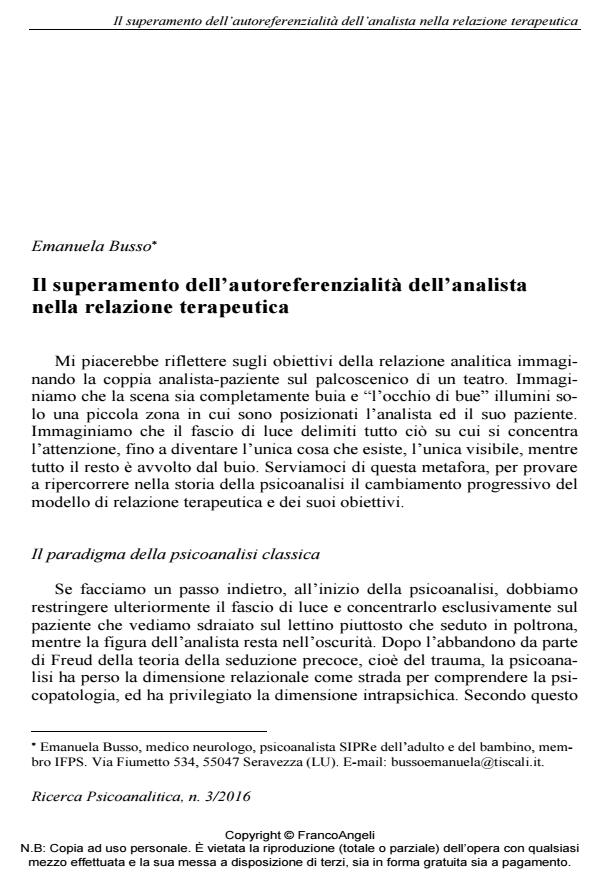Il superamento dell’autoreferenzialità dell’analista nella relazione terapeutica
Titolo Rivista RICERCA PSICOANALITICA
Autori/Curatori Emanuela Busso
Anno di pubblicazione 2016 Fascicolo 2016/3
Lingua Italiano Numero pagine 16 P. 25-40 Dimensione file 182 KB
DOI 10.3280/RPR2016-003003
Il DOI è il codice a barre della proprietà intellettuale: per saperne di più
clicca qui
Qui sotto puoi vedere in anteprima la prima pagina di questo articolo.
Se questo articolo ti interessa, lo puoi acquistare (e scaricare in formato pdf) seguendo le facili indicazioni per acquistare il download credit. Acquista Download Credits per scaricare questo Articolo in formato PDF

FrancoAngeli è membro della Publishers International Linking Association, Inc (PILA)associazione indipendente e non profit per facilitare (attraverso i servizi tecnologici implementati da CrossRef.org) l’accesso degli studiosi ai contenuti digitali nelle pubblicazioni professionali e scientifiche
La psicoanalisi è nata come strumento terapeutico. L’obiettivo dell’analista è curare il paziente, che a sua volta chiede di essere curato per raggiungere una condizione di maggiore benessere o di alleviamento della sofferenza. Da sempre la relazione analista-paziente si è costituita come lo strumento fondamentale della terapia. Dall’analista "archeologo" di Freud, all’analista co-costruttore della relazione e del percorso analitico della psicoanalisi relazionale, in ogni caso alla coppia analista-paziente viene riferito gran parte di ciò che accade e di cui si parla in seduta. Nel primo caso l’attenzione al passato del paziente, nel secondo al presente vissuto da entrambi in seduta. Ritengo che in questo cammino della psicoanalisi l’autoreferenzialità dell’analista sia rimasta invariata. La vita del paziente è fuori dallo studio, ma la realtà spesso resta sullo sfondo, mentre dovrebbe costituire il centro dell’attenzione di entrambi, perché è nel miglioramento della vita del paziente l’obiettivo di cura, ed il lavoro analitico deve servire al futuro del paziente. Solo con una diagnosi e una terapia che tengano conto del contesto relazionale del paziente, è possibile un vero cambiamento.
Parole chiave:Relazione analitica, significato relazionale del sintomo, modello della complessità, contesto relazionale, cambiamento
Emanuela Busso, Il superamento dell’autoreferenzialità dell’analista nella relazione terapeutica in "RICERCA PSICOANALITICA" 3/2016, pp 25-40, DOI: 10.3280/RPR2016-003003